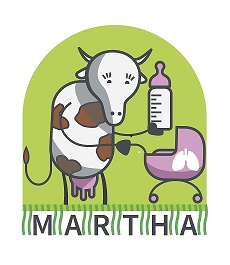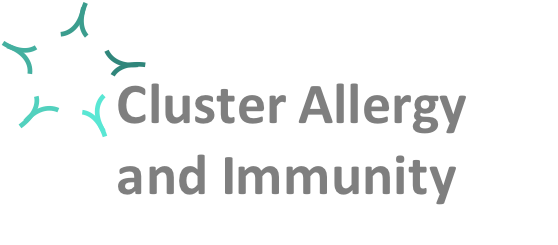News
New DFG funding for research on immune regulatory helminth proteins
![[Translate to Englisch:] ZAUM group leader Julia Esser- von Bieren /quelle HMGU)](/fileadmin/CAI/IMG/externe_Bilder/Julia_Esser-von_Bieren.jpg)
Metabolites of the polyunsaturated fatty acid (PUFA) arachidonic acid (“eicosanoids”) play central and versatile roles in type 2 immune responses e.g. in allergy and asthma. However, current therapies fail to sufficiently target these important mediators. Julia Esser-von Bieren’s team at the ZAUM aims at identifying new molecules, which can regulate eicosanoid-driven airway inflammation. They now received renewed DFG funding to explore the mechanism of action of a newly identified immune- and eicosanoid-regulatory helminth protein. The team is studying potential anti-inflammatory effects of this protein in primary human immune cells and in experimental models of house dust mite allergy and helminth infection.
Publications:
Immune-regulation and -functions of eicosanoid lipid mediators. Esser-von Bieren J. Biol Chem. 2017 Oct
House dust mite drives proinflammatory eicosanoid reprogramming and macrophage effector functions. Henkel FDR, Friedl A, Haid M, Thomas D, Bouchery T, Haimerl P, de Los Reyes Jiménez M, Alessandrini F, Schmidt-Weber CB, Harris NL, Adamski J, Esser-von Bieren J. Allergy. 2019 Jun
ZAUM Research group: link
Martha study- prevention of allergy and asthma

The MARTHA study initiated by Prof. Erika von Mutius is investigating the effect of differently processed milks on the development of asthma and allergies in children. This randomized trial wants to test the already well described protective "farm effect" which was partly explained by the consumption of unprocessed farm milk for an innovative prevention approach. The study team did already recruit over 580 study families.
for more information click here
Salt affects allergic immune reactions

A team working with Prof. Christina Zielinski at the Technical University of Munich (TUM) has demonstrated increased salt concentrations leads to the formation of Th2 cells in vitro, which are key cells in the development of allergic diseases such as atopic dermatitis. The team also detected elevated salt concentrations in the skin of patients with atopic dermatitis, which supports the growth of Staphylococcus aureus a bacterium associated with this disease.
Press release:
Atopic dermatitis: staphylococci-dominated microbiome influence skin barrier function
Staphylococcus aureus is the dominat skin associated bacterium in atopic dermatis. A recently published Paper of CAI Researchers in cooperation with researchers from Zurich could show that this microbiome dysbiosis influence also the skin barrier function.
Publication
Altunbulakli C, Reiger M, Neumann AU, Garzorz-Stark N, Fleming M, Huelpuesch C, Castro-Giner F, Eyerich K, Akdis CA, Traidl-Hoffmann C.
J Allergy Clin Immunol. 2018 Jul
Press release TUM, August 10, 2018 (in german language)
CAI Publications
Next generation pollen monitoring and dissemination.
Buters J, Schmidt-Weber C, Oteros J.
Allergy. 2018 Aug
Russkamp D, Van Vaerenbergh M, Etzold S, Eberlein B, Darsow U, Schiener M, De Smet L, Absmaier M, Biedermann T, Spillner E, Ollert M, Jakob T, Schmidt-Weber CB, de Graaf DC, Blank S.
Toxicon. 2018 Aug
Gorlanova O, Illi S, Toncheva AA, Usemann J, Latzin P, Kabesch M, Dalphin JC, Lauener R, Pekkanen JR, Von Mutius E, Riedler J, Kuehni CE, Röösli M, Frey U; BILD and PASTURE study groups.
Allergy. 2018 Jul
Altunbulakli C, Reiger M, Neumann AU, Garzorz-Stark N, Fleming M, Huelpuesch C, Castro-Giner F, Eyerich K, Akdis CA, Traidl-Hoffmann C.
J Allergy Clin Immunol. 2018 Jul
Artemisia pollen is the main vector for airborne endotoxin.
Oteros J, Bartusel E, Alessandrini F, Núñez A, Moreno DA, Behrendt H, Schmidt-Weber C, Traidl-Hoffmann C, Buters J.
J Allergy Clin Immunol. 2018 Jul
Aglas L, Gilles S, Bauer R, Huber S, Araujo GR, Mueller G, Scheiblhofer S, Amisi M, Dang HH, Briza P, Bohle B, Horejs-Hoeck J, Traidl-Hoffmann C, Ferreira F.
J Allergy Clin Immunol. 2018 May
Dehmel S, Nathan P, Bartel S, El-Merhie N, Scherb H, Milger K, John-Schuster G, Yildirim AO, Hylkema M, Irmler M, Beckers J, Schaub B, Eickelberg O, Krauss-Etschmann S.
Sci Rep. 2018 May
Activin-A Is a Pro-Inflammatory Regulator in Type-2-Driven Upper Airway Disease.
Chaker AM, Zissler UM, Poulos N, Wagenmann M, Bas M, Gürth F, Xanthou G, Schmidt-Weber C
Int Arch Allergy Immunol. 2018
Cutaneous Barriers and Skin Immunity: Differentiating A Connected Network.
Eyerich S, Eyerich K, Traidl-Hoffmann C, Biedermann T.
2018, Trends Immunol. - Review.
Type I immune response induces keratinocyte necroptosis and is associated with interface dermatitis.
Lauffer F, Jargosch M, Krause L, Garzorz-Stark N, Franz R, Roenneberg S, Böhner A, Mueller NS, Theis FJ, Schmidt-Weber CB, Biedermann T,Eyerich S, Eyerich K.
2018, J Invest Dermatol.
The use of pharmacogenomics, epigenomics, and transcriptomics to improve childhood asthma management: Where do we stand?
Farzan N, Vijverberg SJ, Kabesch M, Sterk PJ, Maitland-van der Zee AH.
2018, Pediatr Pulmonol.
Exposure to non-microbial N -Glycolylneuraminic acid protects farmers’ children against airway inflammation and colitis.
Remo Frei, Ruth Ferstl, Caroline Roduit, Mario Ziegler Dipl-Ing, Elisa Schiavi, Weronika Barcik, Noelia Rodriguez-Perez, Oliver F. Wirz, Marcin Wawrzyniak, Benoit Pugin, Dirk Nehrbass, Marek Jutel, Sylwia Smolinska, Patrycja Konieczna, Christian Bieli, Susanne Loeliger, Marco Waser, Göran Pershagen, Josef Riedler, Martin Depner, Bianca Schaub, Jon Genuneit, Harald Renz, Juha Pekkanen, Anne M. Karvonen, Jean-Charles Dalphin, Marianne van Hage, Gert Doekes, Mübeccel Akdis, Charlotte Braun-Fahrländer, Cezmi A. Akdis, Erika von Mutius, Liam O’Mahony, Roger P. Lauener.
2017, J Allergy Clin Immun.
Cabinet approves the electronic pollen information network "ePIN"
Prof. Dr. Jeroen Buters, ZAUM
ePIN-network map press release
New Allergen of insect venom discovered
CAI researcher of the TUM - Department Dermatology and Allergology and the Center of Allergy and environment (ZAUM) in cooperation with researcher from Spain, Luxembourg and Denmark recently discovered Pol d 3, a dipeptidyl peptidase, as the main allergen of the Polistes dominula venom.
The insect Polistes dominula is widespread in Southern Europe as well as in the United States but it will spread due to the climate change also to Western Europe. The discovery of Pol d 3 might form the basis for a proper diagnosis of Polistes venom allergy in the future.


